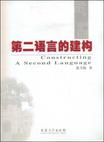第二语言的建构
出版时间:2008-11 出版社:安徽大学出版社 作者:张雪梅 页数:303
内容概要
《第二语言的建构》在评述前人研究成果的基础上,提出了一个全新的二语习得模式,这在理论和方法上均是一大突破。立论正确,有不少创新点,对不同的学派持宽容的态度,取芜存菁,批判地兼收并蓄,资料翔实,叙述层次分明,分析颇具说服力,语言地道,行文流畅。综上所述,这是一篇具有一定理论深度的优秀作品。并提出了新视角、新方法,理论联系实践,对英语教学,特别是二语习得的研究具有一定的指导意义。
作者简介
张雪梅,女,博士,上海外国语大学英语学院副教授,硕士生导师。从事英语教学与研究近20年,研究方向主要为二语习得和英语教学法、语料库语言学。曾参加上海市、教育部和国家社科等多项科研工作。在语言习得语言教学方面发表论文近20篇;译作3部,编写教材和教辅、学术论文集若干。
书籍目录
Preface(序)AcknowledgementsList of abbreviationsChapter 1 The Role of Native Language in Second Language Acquisition1.1 What is language transfer1.1.1 Earlier consideration on transfer1.1.2 Borrowing transfer and substratum transfer1.1.3 Odlin’S contribution1.1.4 Transfer as a controversy in second language acquisition1.2 Second language acquisition development1.2.1 A historical sketch1.2.2 The theoretical approaches1.2.3 Universal Grammar and second language acquisition1.3 Other approaches to SLA1.3.1 Functional typographical framework1.3.2 Information processing approach1.3.3 Variationist approaches1.3.4 Current issues in SLA research1 4 Structure of the book1.5 ConclusionChapter 2 Language Transfer:a Historical Review2.1 Introduction2.2 Historical review2.2.1 Early attempts on language transfer2.2.2 Contrastive Analysis2.2.3 Error Analysis2.2.4 Creative Construction Hypothesis2.2.5 Interlanguage Phase2.3 Recent development2.4 Language transfer revisited:a critical evaluation2.4.1 Selinker’S study2.4.2 Language transfer:reconceptualization2.5 Some personal revelations On language transfer2.6 ConclusionChapter 3 Language Transfer and Universal Grammar3.1 Introduction3.2 Why a Universal Grammar3.2.1 What constitutes knowledge of language3.2.2 How is knowledge of language acquired3.2.3 How is knowledge of language put to use3.3 What does Universal Grammar consist of3.3.1 Principles and Parameters3.3.2 Minimalist Program3.4 UG and L1 acquisition3.4.1 The logical problem3.4.2 Principles in LI acquisition3.4.3 Parameters in LI acquisition3.4.4 Functional categories in L1 acquisition3.5 UG and second language acquisition3.5.1 The differences between L1 acquisition and L2 acquisition3.5.2 Different possibilities of UG' s role in L2 acquisition3.5.3 Functional categories in [2 acquisition3.6 ConclusionChapter 4 The New Research Trends4.1 Introduction4.2 The L2 initial state4.2.1 Full Transfer/Partial Access4.2.2 No Transfer/Full Access4.2.3 Full Transfer/Full Access4.2.4 Partial Transfer/Full Access4.2.5 Partial Transfer/Partial Access4.3 Evidence for the initial state : what counts as data4.4 Interlanguages and stages of [2 development4.4.1 Development : transfer versus no transfer4.4.2 Development : full versus partial access4.5 The L2 final state4.5.1 Ultimate L2 attainments4.5.2 Critical periods4.5.3 Near native speaker competence4.5.4 Non convergent final outcomes4.6 Findings about functional categories in SLA4.7 ConclusionChapter 5 Critical Evaluation of the Linguistic Approach to Second Language Acquisition Researches5.1 Introduction5.2 Critical evaluation of SLA studies within the,framework of UG5.2.1 Strengths5.2.2 Weaknesses5.3 Relevant issues5. 3.1 UG as the theoretical base for SLA studies5.3.2 Children adults differences5.3.3 Phonology5.3.4 Changing views and questions5.3.5 Universal Grammar and language typology5.4 Methodological meditation5.4.1 Theoretical assumptions5.4.2 Methodological survey5.4.3 Grammaticality Judgment tests5.4.4 Acceptability Judgements tests5.4.5 Criteria to be met5.4.6 Some overgeneralizations in SLA researches5.5 Comments from non-UG proponents5.6 Evidence needed to explain the logical problem5.7 ConclusionChapter 6 Language Transfer and Other Explanations6.1 Introduction6.2 Language transfer and SLA in retrospect6.3 Nativism : how far is it away from the UG6.4 Cognitive nativism: not an oxymoron6.4.1 Cognitive modularity6.4.2 Linguistic nativism6.4.3 Developmental nativism6.4.4 General nativism6.4.5 Connectionist nativism6.5 Second language acquisition and beyond6.6 An integrated model of SLA6.6.1 An integrated model6.6.2 Preliminary studies6.7 ConclusionChapter 7 Further Evidence7.1 The tense and aspect system in English7.1.1 Tense7.1.2 Aspect7.2 The simple past and the present perfect in English7.2.1 The simple past tense7.2.2 The present perfect7.3 Simple past versus present perfect7.3.1 Forms7.3.2 Function7.3.3 Use of temporal expressions7.3.4 Summary7.4 Temporality in Chinese7.5 Study I7.5.1 Researeh questions and design7.5.2 Results and analysis7.6 Study II7.6.1 Research questions and design7.6.2 Results and analysis7.7 Findings and discussion7.8 SummaryChapter 8 Conclusion8.1 Introduction8.2 Recapitulation8.3 Critical evaluation of the study8.4 Implications8.5 ConclusionBibliographyAppendix
图书封面
评论、评分、阅读与下载
用户评论 (总计0条)
推荐图书
- 狼与香辛料官方向导书
- 少年科学大讲堂 食品响警报
- 学前班 数字描红多用游戏本
- 催化点金术
- 我会做20以内减法
- 突破――中国资本市场发展之路(上下卷)
- 高等学校英语专业4级考试快速通关
- 何须执手问年华
- 水土一方
- 北京旅游地理
- 每秒千桶
- 2009年全国卫生专业技术资格考试(中级)
- 2009年全国卫生专业技术资格考试临床医学检验技术初级
- 爱的教育
- 爱丽丝漫游奇境
- 经济法
- 2009年初级会计专业技术资格考试经典题解
- 2009年中级会计职称考试梦想成真系列丛书·经典题解·中级会计实务
- 2009年中级会计专业技术资格考试经典题解
- 深层次思考
- 乡村医生基本用药手册
- 儒家法思想通论
- 頭文字D 33
- 頭文字D 34
- 頭文字D 35
